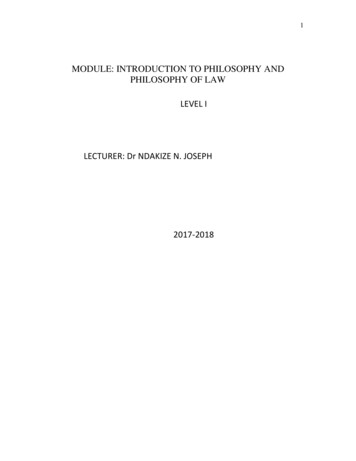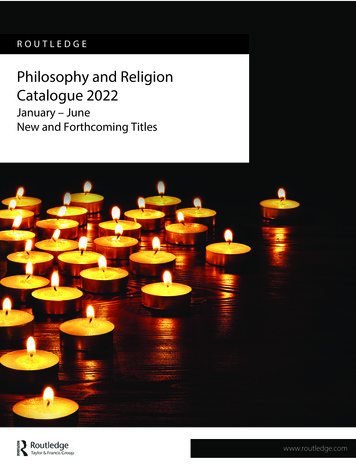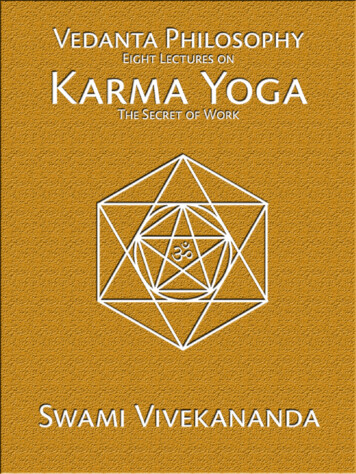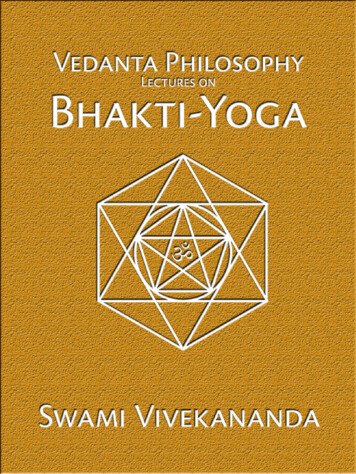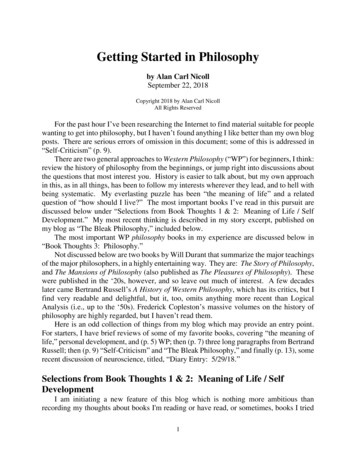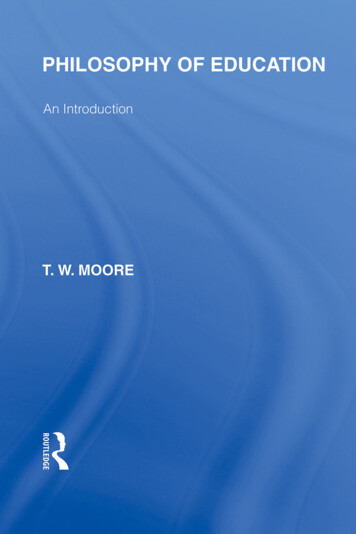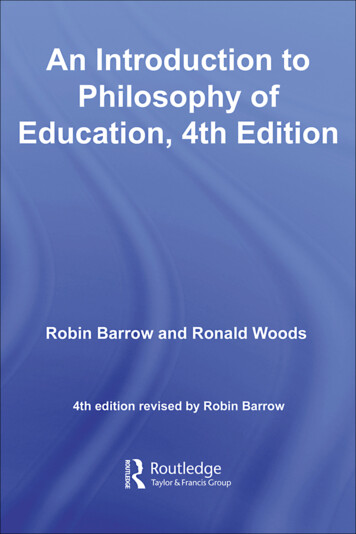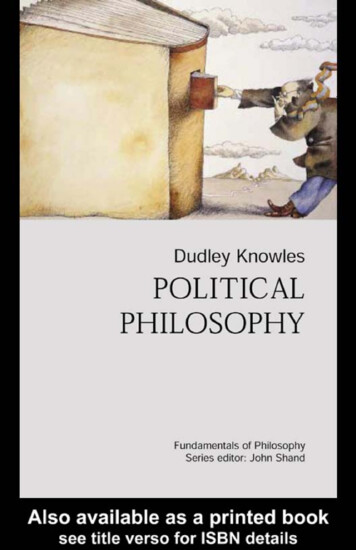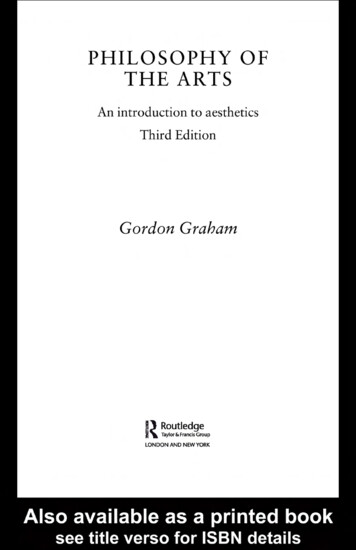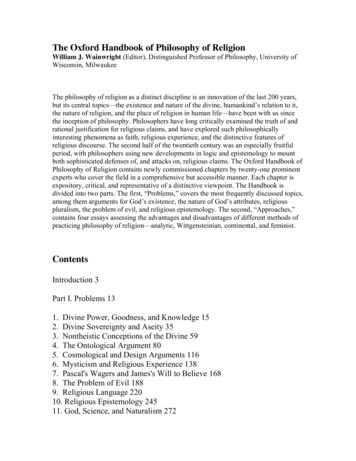
Transcription
PHILOSOPHY OF ARTART“This book will take its place as the very best introduction to the subjecton the market Carroll, because of his vast knowledge of the populararts as well as traditional high arts, both old and new, is able to provide anenormous variety of examples that will speak to a wide audience.”Professor Peter Kivy, Rutgers University“This is analytic philosophy at its best: thorough, rigorous, even-handed,eminently readable throughout Carroll’s book generates anenthusiasm for the subject and liveliness of debate which will guaranteethat its student readership will profit from it and be engaged by it.”Professor Peter Lamarque, University of HullPhilosophy of Art is a textbook for undergraduate students interested inthe topic of philosophical aesthetics. It aims to introduce the techniquesof analytic philosophy in addition to a selection of the major topics inthis field of inquiry. These include the representational theory of art,formalism, neo-formalism, aesthetic theories of art, neoWittgensteinianism, the Institutional Theory of Art, as well as historicalapproaches to the nature of art. Throughout the book, abstractphilosophical theories are illustrated by examples of both traditional andcontemporary art including frequent reference to the avant-garde. In thisway the reader’s understanding of art theory as well as the appreciationof art is enriched.Noël Carroll is the Monroe C.Beardsley Professor of the Philosophy ofArt at the University of Wisconsin-Madison. He is currently alsoPresident of the American Society for Aesthetics and has been adocumentary screenwriter and a journalist. His other books include ThePhilosophy of Horror (Routledge, 1990) and A Philosophy of Mass Art(1998).
Routledge Contemporary Introductions to PhilosophySeries Editor:Paul K.MoserLoyola University of ChicagoThis innovative, well-structured series is for students who have alreadydone an introductory course in philosophy. Each book introduces a coregeneral subject in contemporary philosophy and offers students anaccessible but substantial transition from introductory to higher-levelcollege work in that subject. The series is accessible to nonspecialists andeach book clearly motivates and expounds the problems and positionsintroduced. An orientating chapter briefly introduces its topic andreminds readers of any crucial material they need to have retained from atypical introductory course. Considerable attention is given to explainingthe central philosophical problems of a subject and the main competingsolutions and arguments for those solutions. The primary aim is toeducate students in the main problems, positions and arguments ofcontemporary philosophy rather than to convince students of a singleposition. The initial eight central books in the series are written byexperienced authors and teachers, and treat topics essential to a wellrounded philosophy curriculum.EpistemologyRobert AudiEthicsHarry GenslerMetaphysicsMichael J.LouxPhilosophy of ArtNoël CarrollPhilosophy of LanguageWilliam G.LycanPhilosophy of MindJohn HeilPhilosophy of ReligionKeith E.YandellPhilosophy of ScienceAlexander Rosenberg
PHILOSOPHY OFARTA contemporary introductionNoël CarrollLondon and New York
First published in 1999by Routledge11 New Fetter Lane, London EC4P 4EESimultaneously published in the USA and Canadaby Routledge29 West 35th Street, New York, NY 10001Routledge is an imprint of the Taylor & Francis GroupThis edition published in the Taylor & Francis e-Library, 2002. 1999 Noël CarrollAll rights reserved. No part of this book may be reprinted orreproduced or utilised in any form or by any electronic,mechanical, or other means, now known or hereafterinvented, including photocopying and recording, or in anyinformation storage or retrieval system, without permission inwriting from the publishers.British Library Cataloguing in Publication DataA catalogue record for this book is available from the British LibraryLibrary of Congress Cataloging in Publication DataA catalog record for this book has been requestedISBN 0-415-15963-6 (hbk)ISBN 0-415-15964-4 (pbk)ISBN 0-203-19723-2 Master e-book ISBNISBN 0-203-19726-7 (GlassBook Format)
To Peter Kivy,the Leader of the Band.
ContentsAcknowledgmentsxiIntroduction 1What is philosophy? 2The analytic philosophy of art 5Analysing concepts 7Some peculiarities of philosophical researchThe structure of this book 13The aims of this book 15Chapter 1 Art and representation1118Part IArt as representation 19Art, imitation and representation 19The neo-representational theory of art 26Part II What is representation? 33Pictorial representation 33Traditional approaches to pictorial representation 34The conventionalist theory of pictorial representation 39A neo-naturalist theory of pictorial representation 42Representation across the arts 49Chapter summary 56Annotated reading 56Chapter 2 Art and expression58Part IArt as expression 59The expression theory of art 59Objections to the expression theory of artPart II Theories of expression 79What is expression? 79Expression, exemplification and metaphor6686
viiiCONTENTSSome problems with the theory of metaphoricalexemplification 93Is expression always metaphorical? 95Chapter summary 104Annotated reading 106Chapter 3 Art and form107Part IArt as form 108Formalism 108Objections to formalism 115Neoformalism 125Part II What is artistic form? 137Different views of artistic formForm and function 142Form and appreciation 148Chapter summary 152Annotated reading 153Chapter 4 Art and aesthetic experience137155Part IAesthetic theories of art 156Art and aesthetics 156The aesthetic definition of art 160Two versions of aesthetic experience 168Objections to the aesthetic definition of art 174Part II The aesthetic dimension 182Aesthetic experience revisited 182Aesthetic properties 189Detection or projection? 192Aesthetic experience and the experience of art 200Chapter summary 202Annotated reading 203Chapter 5 Art, definition and identification205Part IAgainst definition 206Neo-Wittgensteinianism: art as an open conceptObjections to Neo-Wittgensteinianism 218Part II Two contemporary definitions of art 224The Institutional Theory of Art 224Defining art historically 240206
CONTENTSPart III Identifying art 249Definition and identification 249Identification and historical narration 251Historical narratives: their strengths and weaknessesChapter summary 265Annotated reading 266Index269258ix
AcknowledgmentsThe author wishes to thank Philip Alperson, Jim Anderson, Sally Banes,David Bordwell, Hugh Carroll III, Jinhee Choi, Dong-Ryul Choo, PeterKivy, Peter Lamarque, Steven Nadler, Prashant Parikh and Elliott Soberfor their generous suggestions for improving this book. They, of course,are not responsible for the errors herein. I don’t know who is.
IntroductionWhat is philosophy?The analytic philosophy of artAnalysing conceptsSome peculiarities of philosophical researchThe structure of this bookThe aims of this book
IntroductionWhat is philosophy?The word “philosophy” has many different meanings. Sometimespeople tell you about their philosophy of life. They usually meansomething like their deepest and most abiding beliefs. This is certainlyan acceptable usage of the word in ordinary language but it is a broaderconception of philosophy than that which will preoccupy us in this book.Herein, “philosophy” will generally refer to a certain academic discipline.Of course, like many academic disciplines, philosophy can be approachedin a number of different ways. That is, there are many different schools ofphilosophy, such as existentialism, phenomenology, marxism,deconstructionism, and so on. Though related in various respects, thedifferent schools of academic philosophy often have different aims andemphases. The type of philosophy that we will be exploring in this book isoften called analytic philosophy. In fact, the title of this book could beaccurately expanded as the Analytic Philosophy of Art: A ContemporaryIntroduction. This book is an introduction to some of the major techniquesand central problems of the analytic philosophy of art.But what is analytic philosophy? It is a school of philosophy primarilypracticed in the English-speaking world. Thus, it is sometimes called “AngloAmerican” philosophy, though that is a somewhat misleading label because itis not by any means the only form of academic philosophy in the Englishspeaking world. However, it is a very prominent school, some might say thedominant school, of English-speaking philosophy, and it has exertedconsiderable influence throughout the twentieth century. But this is only tosuggest the “where” and the “when” of analytic philosophy. The “what”remains to be explained.This school of thought is called analytic philosophy. So a natural firstquestion is: “What exactly does this school of philosophy analyse?”Simplifying drastically, we might say that what analytic philosophy analyses
INTRODUCTION3are concepts. That is why it is sometimes also called conceptual analysis.Though by this point in history, many philosophers would argue that this isnot all that analytic philosophy does, for purposes of introducing the topic, itis fair to say that this is what many analytic philosophers have attempted todo in the past and what many, at least part of the time, continue to do today.They analyse concepts.Concepts, of course, are fundamental to human life. Concepts organize ourpractices. The concept of a person, for example, is central to myriad practices,including politics, morality, the law, and so on. The concept of a number isfundamental to mathematics, while the concept of knowledge is indispensablethroughout the widest gamut of human activities. Without such concepts, theactivities in question would not exist. For example, without the concept of aperson, there would be no morality as we know it for it is persons, not merethings, to which morality pertains.A rough and ready way to characterize analytic philosophy is to say that itis concerned with the analysis of concepts that are key to human practices andactivities, including not only those of enquiry, like science, but, as well, ofpragmatic endeavors, such as governance. Analytic philosophers, in thisregard, may trace their heritage back to Socrates, who walked the streets ofancient Athens asking “What is knowledge?” and “What is justice?” in waysthat undermined commonplace and often complacent answers to thesequestions, thus paving the way, the analytic philosopher might say (in aslightly self-congratulatory tone of voice), for more rigorous analyses.Those of you who’ve spent some time thumbing through college bulletinshave probably noticed that the philosophy section is full of titles that take theform “the philosophy of . The blank is often filled in by the name ofsome other field—as in the philosophy of science, or of logic, or of art, law,history and so forth. Philosophy generally seems to be the philosophy ofsomething. But what sort of something?That something is a practice, like law or religion. Very often it is a practiceinvolved with acquiring knowledge—like physics, psychology, history, andthe like. But it may also be a practical activity, such as ethics. Philosophybegins when the people involved in the relevant practices become selfconscious—when they begin to wonder about just what it is that they aredoing or just what they are really talking about.That is, each one of these practices organizes its field of operation in termsof certain concepts, which are applied according to certain criteria. Inaddition, each of these practices employs certain recurrent modes of reasoning—certain ways of connecting concepts—which modes are appropriateto the point of achieving the goals of the practice in question. These conceptsand modes of reasoning are what make the practice possible— they are what,so to speak, constitutes the practice. And it is such concepts and modes ofreasoning that analytic philosophy analyses.
4PHILOSOPHY OF ARTTo be more concrete, consider the case of the law. It is a practice. Itpossesses a large number of key concepts—concepts without which therewould be no practice of law. One such concept, quite obviously, is the verynotion of law itself. What is a law? Under what conditions—according to whatcriteria—do we classify an injunction as a law? This is the kind of questionthat practitioners of the field ask when they become self-conscious abouttheir practice. It is the point at which the philosophy of law takes off.In asking “What is a law?” different options need to be explored. Is a lawjust what some duly appointed assembly decides is a law in accordance withcertain established procedures? Or is a law—a genuine law—such that itmust follow from or at least be consistent with deep principles— perhapsdeep constitutional principles or deep moral principles, involving humanrights? What arguments can be brought forward on behalf of these differentoptions?Such questions, needless to say, are not idle. They may come to the forewhen, for example, someone maintains that a draft law is illegal. Of course, toallege that a draft law—or, for that matter, any law—is illegal—i.e., is againstthe law—brings us to the very brink of paradox. In order to resolve suchparadoxes and puzzles, as arise frequently in our practices, we need to take aclose look at our concepts. And that is the vocation of analytic philosophy.In addressing questions such as “What is a law?” analytic philosophers,among other things, attempt to identify the criteria that we use to categorizethings one way rather than another. Sometimes this is dismissed as merelyplaying with words. However, when one considers how very much can ride onquestions of categorization, it seems that analytic philosophers are generallyless naïve than those who disparage them as “mere logic choppers.”Throughout much of the twentieth century, analytic philosophy hasincreasingly become a “second order” form of enquiry. It is the philosophy ofthis or that—the philosophy of physics, or of economics, or of art. Analyticphilosophers take as their domain significant forms of human practice, butunlike the social scientist, the analytic philosopher does not look forrecurring patterns of social behavior within said practices. Instead, theanalytic philosopher tries to clarify the concepts that make activities withinthe relevant domains possible. Analytic philosophers, in other words, do notattempt to ascertain answers to empirical questions like “How many peopleobey the law?” but rather address questions like “What does it take forsomething to count as a law?” or, to state the matter in more linguistictrappings: “What does it mean to call something a ‘law’?”Undoubtedly, learning how many people obey the law is crucial fordesigning social policy. But discovering what a law is, or attempting to do so,is an important project too, since if we ignore this question, we will be leftwondering whether our practice is intelligible—whether it hangs together,and has any rhyme or reason. By interrogating the deep concepts that
INTRODUCTION5organize our practices—that make our practices possible—the analyticphilosopher attempts to reveal what sense those practices have. This is not theonly form of philosophy imaginable, but it is a significant form. Indeed,philosophers of other schools must also be analytic philosophers at least someof the time. For example, the marxist philosopher must ask “What isexploitation?”Perhaps the notion that what analytic philosophers do is to analyse orclarify concepts strikes you initially as somewhat obscure. In what follows, itis to be hoped that that feeling of obscurity will be relieved. However, even atthis juncture, the idea of clarifying concepts should not be utterly alien toyou, since for the last few pages, we have been analysing a concept —namely,the concept of analytic philosophy. To the extent that you have followed thediscussion so far, you have taken your first steps as an analytic philosopher. Ifyou wish to know more about it, things are going very well.The analytic philosophy of artAnalytic philosophy analyses the concepts that are fundamental to our practices.Art is a recurring form of human practice. Some have argued that all humansocieties show evidence of artistic activities. The purpose of the analytic philosophyof art is to explore the concepts that make creating and thinking about art possible.Some of these concepts include: the very concept of art itself, as well as the conceptsof representation, expression, artistic form, and aesthetics. These concepts will bediscussed at some length in this book.But there are also further concepts that the philosopher might look at,such as interpretation, forgery, creativity, and artistic value, among others. Aphilosopher of art might concentrate on specific artforms—asking “What isliterature (dance, music, film, drama, and so forth)?” Or, she might explorethe concepts of certain artistic genres, such as fiction, comedy, tragedy,poetry, and the like. All these and more are the concepts that the analyticphilosophy of art takes as its subject matter.As with the philosophy of law, so with the philosophy of art, coming tounderstand these concepts is an important contribution to the life of thepractices in which they figure, often constitutively. We have suggested howcentral the concept of the law is to the practice of jurisprudence. Similarly, theconcept of art is fundamental to our artistic practices. Without some sense ofhow to classify certain objects and performances as artworks, the Museum ofModern Art wouldn’t know what to collect, the National Endowment for theArts wouldn’t know to whom to give money, nor would the United Statesgovernment know which institutions deserve tax relief for the preservation
6PHILOSOPHY OF ARTof our artistic past. Nor even, without some command of the concept of art,would economists know how to evaluate empirical claims like “Art is asignificant component of the financial well-being of New York City.”But far more important than the preceding “official” uses of the concept ofart is the role the concept plays in our personal, ongoing commerce withartworks, si n c e h o w w e r e s p o n d t o a n o b j e c t — i n t e r p r e t i v e l y,appreciatively, emotively, and evaluatively—depends decisively uponwhether or not we categorize it as an artwork. Suppose we come across aliving, breathing couple seated at opposite sides of a wooden table,staring intently at each other. Ordinarily we might pay no attention tothem at all, or avert our glance out of a sense of politeness. But if wecategorize the situation as an artwork—as the performance piece NightC r o s s i n g b y M a r i n a A b r a m o v i c a n d U l ay — o u r r e s p o n s e w i l l b ealtogether different.We will shamelessly scrutinize the scene carefully, attempt tointerpret it, perhaps in terms of what it says about human life andrelationships. We will try to situate it in the history of art, comparing itto other artworks in various genres. We will contemplate what itexpresses and what feelings it arouses in us, and we may evaluate it—possibly commending it for drawing our attention to neglected realms ofexperience, or for moving us, or for making its point with a startlingeconomy of means. Or maybe we will criticize it for being boring orhackneyed. But in any event, it is clear that once we categorize thesituation as an artwork, our response to it will differ radically from theway in which we regard comparable seated couples in “real” life.Or consider surgical procedures. In the everyday course of life, we donot think of them as alternatives to a night at the opera. But when suchprocedures are incorporated in a performance piece such as the workImage/New Image(s) or the Re-incarnation of Saint-Orlan and wecategorize Orlan’s plastic surgery as a work of art, we see it in a differentlight. We note the interesting color arrangement of the surgeons’uniforms and we ask about the meaning of Orlan’s self-elected decisionto go under the knife—what does it say about society, about women,about personal identity, about art history and the ideals of female beautyfound there? That is, we react to the event completely differently fromhow we would, had we happened upon an ordinary gall-bladderoperation. The attempt to interpret the meaning of your typical gallbladder operation is out of place, but the attempt to interpret an artworkis usually appropriate. Yet interpretation here hinges on whether or notwe classify the item in question as an artwork—on whether we correctlyapply the concept of art to it.Thus, clarifying our concept of art is not merely a matter of dry, academicbook-keeping. It lies at the living heart of our artistic practices, since
INTRODUCTION7categorizing candidates as artworks puts us in a position to mobilize a set ofart responses that are the very stuff of our activities as viewers, listeners andreaders. In order to play the game, we need a handle on the concept of art. Andit is the task of the analytic philosophy of art to make sure that that handle isa sturdy one by reflecting upon the concept of art and articulating itselements in as precise a manner as possible.As already indicated, the concept of art is not the only one thatpreoccupies analytic philosophers of art, though for the reasons just stated, itis a central one. Representation, expression, artistic form, aestheticexperience and aesthetic properties are also of great interest. Consequently,much of the remainder of this book will be spent analysing these six concepts.Other concepts might have been chosen for analysis; however, for a text ofthis length, these should supply the inquiring student with a serviceableintroduction to the field.Analysing conceptsThe phrase “analysing concepts” has been bandied about extensively in thisintroduction. But what does it involve? How do you go about analysingconcepts? Since so much time will be spent in what follows analysingconcepts, some opening comments may be helpful here.Like most issues in philosophy, there is substantial debate about whatconcepts are and how to analyse them. However, there is one very standardapproach (though as we shall see in Chapter 5, it has not enlisted universalassent). We can call this standard approach the method of necessary andsufficient conditions. It proceeds by breaking concepts down into theirnecessary and sufficient conditions for application. Although this method iscontroversial, we shall presume its practicability for most of this text, if onlybecause it is a powerful tool for organizing and guiding research, even ifultimately it rests on certain questionable assumptions.The standard approach takes concepts to be categories. Applying a certainconcept to an object is a matter of classifying it as a member of the relevantcategory. Calling an object an artwork involves determining that it meets thecriteria or conditions required for membership in the category. Analysing aconcept is a matter of breaking it down into its component parts, where thecomponent parts are its conditions for application.Think of the concept bachelor. What is a bachelor? A bachelor is anunmarried man. We can break down or analyse the concept of bachelor intotwo component parts—manhood and unmarriedness. In order to be countedas a member of the category bachelor—in order to apply correctly the concept
8PHILOSOPHY OF ARTof bachelor to a candidate—the candidate must meet two conditions: he mustbe a man and he must be unmarried. Individually, each of these conditions isnecessary for anything to count as a bachelor, and together (conjointly) theyare sufficient (just enough) to categorize a candidate as a bachelor. Analysingthe concept of bachelor—which might also be called “defining ‘bachelor’” —is a matter of articulating the necessary and sufficient conditions for applyingthe concept bachelor to, for instance, the boy next door.This method of analysing concepts should seem fairlycommonsensical. When you want to know what something , like abachelor, is, you want to know (1) the feature or features of the kind inquestion that every proper member of the category possesses; and (2)you want to know what feature or features differentiate members of therelevant kind or category from members of other kinds. For example, ifyou want to know what a bachelor is—how to apply the conceptbachelor—then you want to know what all bachelors have in commonand also what sets bachelors apart from other kinds of things, such ashusbands and spinsters.That is, you want to know what feature or features are necessarilypossessed by all the proper members of the category, such that absence ofthe feature in question precludes membership in the category (were theboy next door married, he would not be a bachelor). And you want toknow what feature or features are sufficient to differentiate members ofthe relevant category from members of other categories (were the boynext door an unmarried male, he could not be a husband or a spinster).Unmarriedness and maleness are each individually necessary conditionsfor bachelorhood; together, these criteria represent a sufficient conditionfor bachelorhood.There is a very useful way of setting out these ideas. Since we willemploy it throughout the text, it will be beneficial to introduce it here. “xis a necessary condition for y” means that something can be a y only if itis an x. Someone can be a princess only if she is a woman. Being a womanis not a sufficient condition for being a princess. But it is necessary; it is anecessary requirement for being a princess that one be a woman.Someone may be a woman and not a princess, but one cannot be aprincess and not a woman. Womanhood is a necessary condition forprincesshood, or, to state it formulaically: y is a princess only if y is awoman. Here the truth of “y is a woman” is a necessary condition—anunvarying requirement—for the truth of “y is a princess.”We cannot, however, say that if y is a woman, then she is a princess.Most women are not princesses. Womanhood is not a sufficient conditionfor princesshood; it is not enough to establish princesshood. Somethingelse needs to be added. A likely candidate is that y be of royal lineage,where that is to be determined by the laws of the lands in question. Then
INTRODUCTION9we could say that if y is a woman and of the right royal lineage, then y isa princess. That is, the antecedent clause of the proposition— “y is awoman and of the right royal lineage” —guarantees the truth of theconsequent clause of the proposition “y is a princess.”In the preceding example, womanhood and the right royal lineage areeach individually necessary conditions for princesshood and conjointlythey comprise a sufficient condition for princesshood. To summarize thisinformation formulaically, we can say: y is a princess if and only if (1) yis a woman and (2) y is of the right royal lineage.The locution “if and only if” signals that this analysis is proposingnecessary conditions (the “only if” conditions) and sufficient conditions(the “if” conditions) for princesshood. Similarly, y is a bachelor if andonly if (1) y is a male and (2) y is unmarried. Here conditions (1) and (2)are each on their own necessary conditions for bachelorhood andtogether they are jointly sufficient for bachelorhood.This kind of analysis is often called a real or an essential definition.That it is a definition of the relevant concept should be evident. It is anessential definition because it attempts to get at the essential features ofthe concept —its necessary and sufficient conditions of application. It issaid to be a real definition of the concept because unlike so manydictionary definitions it does not simply track how people commonly usethe concept, but allegedly discovers the real conditions of application ofthe concept.You will encounter many definitions of this sort in this book—set outin terms of the schema “x if and only if y.” Some of these will includeanalyses of pictorial representation and artistic form. There will also be alarge number of proposed analyses of the concept of an artwork,articulated in terms of necessary and sufficient conditions. Sometimesthe text will refer to these as theories of art, sometimes as essential orreal definitions. The variations in terminology should not throw you. Ineach case, we are talking about attempted analyses of the concept of art.This brief review of the method of necessary and sufficient conditionsor, less cumbersomely, the essential definition approach to analysingconcepts, is intended to give you some idea of what is meant by thephrase “analysing concepts.” After all, we’ve been using and will use thatnotion a lot, and you have a right to some concrete sense of what thatabstraction might involve. However, it was also noted that this approachto the way in which we go about applying concepts is controversial andthat alternative views will be explored in the last chapter of this book.Yet until the last chapter, we will be employing this approach toanalysing concepts pretty much without worrying about its adequacy.This might strike you as strange and even irresponsible, if the approach isreally disputed. But let me make two remarks on behalf of this procedure.
10PHILOSOPHY OF ARTOne objection to the essential definition approach is that many of ourconcepts are applied without resort to necessary and sufficientconditions. Arguably, many of our concepts do not have necessary and/orsuffficient conditions of application. There is no reason to presume thatthe concepts that we explore by means of this method will turn out to beanalysable in terms of necessary and/or sufficient conditions. That is afair observation. However, since we won’t know whether a given conceptis congenial to this mode of analysis until we’ve tried it, we have nogrounds for dismissing this approach from the get-go.Second, even if the method
emphases. The type of philosophy that we will be exploring in this book is often called analytic philosophy. In fact, the title of this book could be accurately expanded as the Analytic Philosophy of Art: A Contemporary Introduction. This book is an introduction to some of the major techniques and central problems of the analytic philosophy of art.
